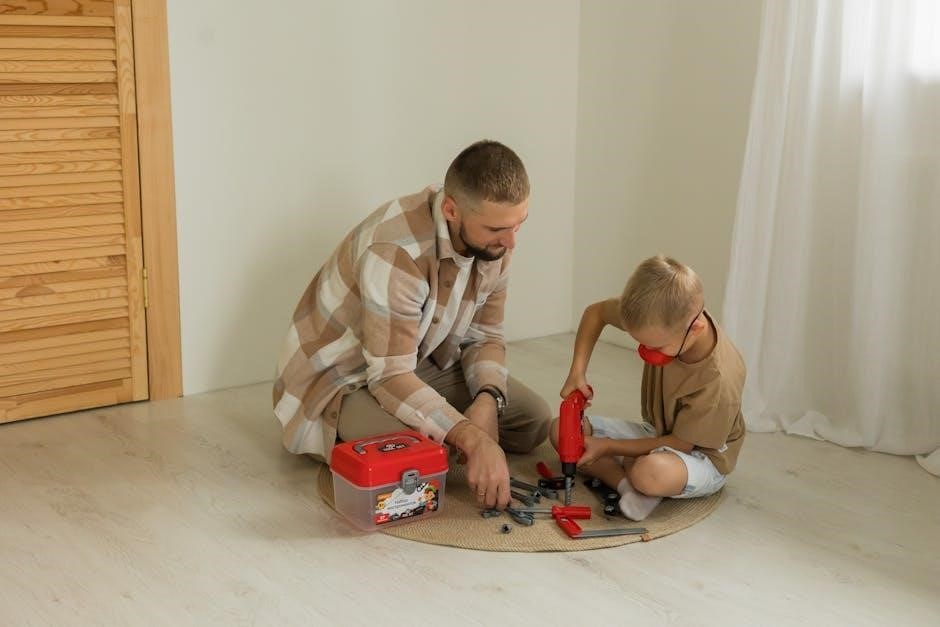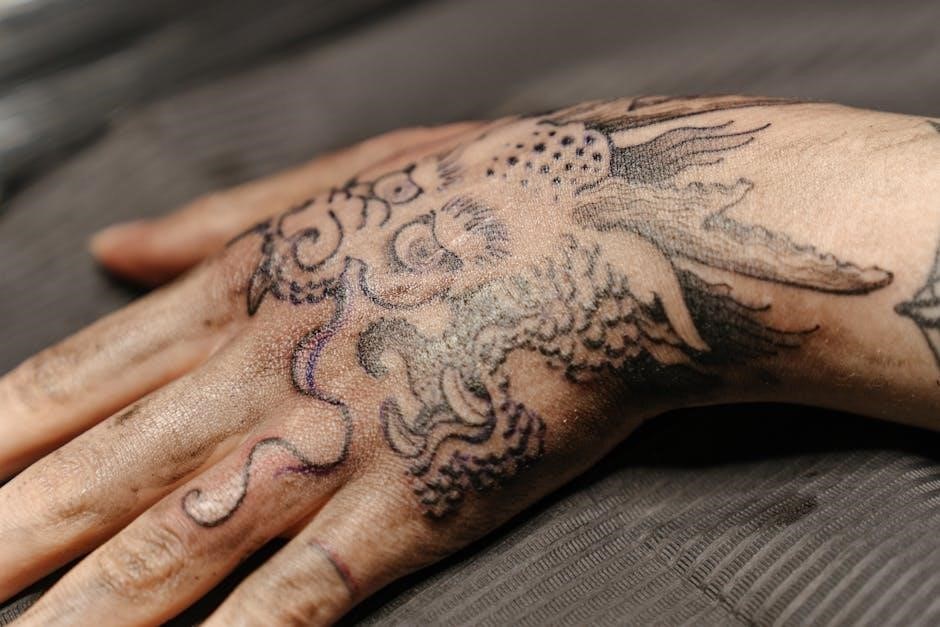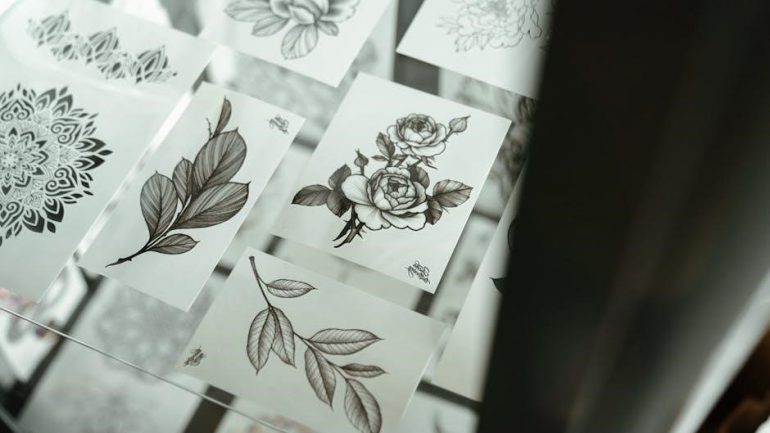Tattooing is a vibrant form of self-expression and art, offering a creative outlet for individuals․ This guide provides a comprehensive introduction to tattooing basics, safety, and techniques․
1․1 What is Tattooing?
Tattooing is an ancient art form that involves inserting ink into the skin to create permanent designs․ It serves as a powerful medium for self-expression, cultural identity, and personal storytelling․ This guide introduces the basics of tattooing, including its history, techniques, and safety practices․ Whether you’re an aspiring artist or a curious beginner, understanding the fundamentals of tattooing is essential for creating meaningful and safe designs․ Learn how to transform ideas into lasting art while adhering to proper hygiene and safety standards․
1․2 Brief History of Tattooing
Tattooing has ancient roots, with evidence of its practice dating back thousands of years․ Early civilizations used tattoos for cultural, spiritual, and decorative purposes․ Polynesian and Japanese cultures, for example, developed intricate tattooing techniques that remain influential today․ The art form evolved over centuries, with modern tattooing emerging in the 19th century․ Today, tattooing is a global phenomenon, blending traditional methods with contemporary designs․ This guide explores its rich history and how it has become a popular form of self-expression and artistic creativity in modern times․
1․3 Modern Tattooing Practices
Modern tattooing combines traditional techniques with advanced technology․ Tattoo machines are now more precise, allowing for intricate designs․ The rise of digital tools has made designing tattoos easier․ Popular styles like realism, minimalist, and neo-traditional are in demand․ Safety standards have improved, with sterilization and disposable equipment being priorities․ Social media has also transformed the industry, enabling artists to showcase their work globally․ Today, tattooing is a vibrant art form, blending creativity with innovation to meet diverse client preferences and aesthetic goals․

Understanding the Basics of Tattooing
Tattooing involves inserting ink into the skin using a machine․ It requires patience, skill, and knowledge of techniques, equipment, and safety protocols to create art safely․
2․1 Key Concepts Every Beginner Should Know
For beginners, understanding the fundamentals of tattooing is crucial․ Key concepts include the proper use of tattoo machines, needle types, and ink․ Hygiene and safety are paramount to prevent infections․ Knowing how to prepare the skin and apply consistent pressure is essential for even ink distribution․ Beginners should also learn about aftercare to promote healing․ Practicing on fake skin before working on real skin builds confidence and skill․ These basics form the foundation for mastering tattooing techniques and ensuring safe, professional results․
2․2 Essential Tattooing Equipment
Essential tattooing equipment includes a tattoo machine, needles, ink, and a power supply․ The machine drives the needle to puncture the skin and deposit ink․ Needles come in various types, such as linework or shading․ High-quality ink ensures vibrant and long-lasting colors․ A power supply regulates the machine’s speed․ Other necessities include disposable gloves, sterile wipes, and a tattoo bed for comfort․ Proper equipment ensures safety, precision, and professional results for both artists and clients․
2․3 Differences Between Various Tattoo Styles
Tattoo styles vary widely, each with unique characteristics․ Realism focuses on detailed, lifelike designs, often requiring advanced techniques․ Tribal tattoos feature bold black lines and geometric patterns, rooted in cultural traditions․ Minimalist styles emphasize simplicity with clean lines and small designs․ Understanding these differences helps beginners choose a style that aligns with their artistic vision and skill level, ensuring a fulfilling creative journey in tattooing․

Safety and Hygiene in Tattooing
Safety and hygiene are crucial in tattooing to prevent infections and ensure a clean environment․ Proper sterilization, disposable needles, and gloves are essential for protecting both artist and client․
3․1 Importance of Proper Hygiene Practices
Proper hygiene practices are vital in tattooing to prevent infections and maintain a safe environment․ Sterilizing equipment using autoclaves ensures all tools are bacteria-free․ Disposable needles and gloves protect both the artist and client from cross-contamination․ Regular handwashing and the use of barrier creams are essential․ Cleaning the skin with antibacterial soap before tattooing reduces infection risks․ Maintaining a clean workspace with disposable sheets or plastic coverings also plays a key role․ Proper hygiene builds trust and ensures a healthy tattooing experience for everyone involved․
3․2 Necessary Safety Equipment
Necessary safety equipment ensures a protected tattooing process․ Disposable needles prevent cross-contamination and infections․ Gloves are essential for both the artist and client to maintain hygiene․ An autoclave sterilizes equipment, ensuring bacteria-free tools․ Protective eyewear like goggles shields from ink splatters․ A face mask reduces airborne contamination risks․ Non-latex gloves are recommended for artists with allergies․ High-quality, sterile ink cartridges prevent infection․ A first aid kit is crucial for emergencies․ Disposable razors prepare the skin safely․ These tools collectively ensure a hygienic and secure tattooing environment for all involved․
3․3 How to Sterilize Tattoo Equipment

Sterilizing tattoo equipment is crucial for preventing infections․ Start by cleaning equipment with soap and water․ Use an autoclave for high-pressure steam sterilization, the most reliable method․ Ultrasonic cleaners can be used for surface cleaning but do not sterilize․ Sanitizer sprays can disinfect surfaces but are not suitable for equipment․ Always follow manufacturer instructions․ Ensure needles and tubes are single-use․ Store sterilized items in sealed pouches until use․ Proper sterilization ensures safety and prevents health risks for both the artist and client․

Choosing the Right Equipment for Beginners
Invest in affordable yet reliable tattoo machines, high-quality needles, and ink․ Start with a basic equipment kit and practice skin to hone your skills effectively․
4․1 What Makes a Tattoo Machine Good for Beginners
A good tattoo machine for beginners balances quality and simplicity, with lightweight designs, adjustable speed settings, and ease of use․ Look for machines with clear instructions and minimal maintenance․ They should also have interchangeable needle cartridges and compatible ink systems․ A machine that operates smoothly at lower speeds is ideal for practicing basic techniques without causing unnecessary stress or fatigue․ Ensure it’s durable and reliable to handle consistent practice sessions effectively․
4․2 How to Set Up Your Tattoo Machine
Setting up your tattoo machine involves attaching the grip, installing the needle, and connecting the power supply․ Ensure the needle is securely tightened and the machine is set to the correct voltage․ Adjust the machine’s stroke and speed according to the type of work․ Always follow the manufacturer’s instructions for specific settings․ Keep the machine clean and well-lubricated for smooth operation․ Practice adjusting and handling the machine before working on skin to build familiarity and confidence․ Proper setup is crucial for consistent results and safety․
4․3 Importance of High-Quality Tattoo Supplies
Using high-quality tattoo supplies is essential for safety, performance, and durability․ Ink, needles, and gloves must meet health standards to prevent infections․ Durable tattoo machines ensure consistent results, while premium ink provides vibrant, long-lasting colors․ Cheap supplies can lead to poor outcomes and health risks․ Investing in reputable brands guarantees reliability and client satisfaction․ Always prioritize quality to maintain professionalism and safety in your tattooing journey․

Practicing and Building Your Skills
Mastering tattooing requires dedication and consistent practice․ Start with fake skin to refine techniques, then progress to human skin under supervision․ Continuous practice enhances precision, confidence, and creativity, helping you develop a unique style and improve client satisfaction․ Regular training and feedback are crucial for skill growth and professionalism in tattooing․
5․1 How to Start Practicing on Fake Skin
Beginners should start by practicing on fake skin, which mimics human skin texture․ Purchase synthetic skin or practice pads and set up your machine according to the manufacturer’s guidelines․ Start with basic lines, shading, and shapes to build control and confidence․ Observe how the needle interacts with the material and adjust your technique․ Regular practice on fake skin helps develop muscle memory and precision before progressing to real skin․ This step is crucial for mastering the fundamentals of tattooing safely and effectively․
5․2 Tips for Your First Tattoo on Human Skin
When performing your first tattoo on human skin, start with a simple design and choose an area with less complex curves, like the forearm or calf․ Ensure the skin is clean and properly prepared․ Use a steady hand and maintain consistent needle depth․ Communicate clearly with your client about discomfort and take short breaks if needed․ Follow proper hygiene practices and use sterile equipment to minimize risks․ After completing, provide clear aftercare instructions to promote healing and ensure the best results for both you and your client․
5․3 The Role of Continuous Practice in Skill Development
Continuous practice is crucial for refining tattooing skills․ Regular sessions on fake skin or willing clients help improve technique, precision, and consistency․ Focus on mastering basic elements like line work, shading, and color blending․ Analyze feedback to identify areas for improvement․ Observing experienced artists and staying updated on trends can inspire growth․ Patience and dedication are key, as skill development takes time․ Consistent practice builds confidence, enhances creativity, and ensures progress toward becoming a skilled tattoo artist․

Design and Creativity in Tattooing
Design and creativity in tattooing involve understanding composition, balance, and personal expression․ Inspiration can come from various styles, ensuring unique, meaningful designs that reflect individuality and artistry․
6․1 How to Create Your Own Tattoo Designs
Creating your own tattoo designs begins with sketching ideas and researching inspiration․ Use reference materials or digital tools to refine concepts․ Consider the body’s curvature and placement for a cohesive look․ Simplify designs for beginners, focusing on bold lines and minimal details․ Incorporate personal symbolism or meaningful elements to make the design unique․ Experiment with different styles, ensuring the final piece reflects your artistic vision and suits the client’s preferences․
6․2 Understanding Placement and Symmetry
Placement is crucial for a tattoo’s aesthetic appeal, as it must complement the body’s contours and proportions․ Consider the location carefully, ensuring the design flows naturally with the skin’s curves․ Symmetry enhances balance and visual harmony, especially in geometric or tribal styles․ Use measuring tools or grid systems to achieve precise alignment․ Placement also affects visibility and longevity, so consider how the tattoo will look as the body ages․ Always discuss placement options with clients to ensure their satisfaction with the final result․
6․3 Drawing Inspiration from Different Tattoo Styles
Drawing inspiration from various tattoo styles is key to developing your artistic voice․ Explore realism, minimalism, or traditional styles to understand their unique elements․ Study how different techniques create texture, shading, or line work․ Incorporate elements from multiple styles to craft unique designs․ Use reference images to analyze composition and detail․ Sketching and brainstorming help refine your ideas․ Remember, inspiration is a foundation, but adding your personal touch ensures originality․ Balancing creativity with respect for existing styles fosters innovative tattoo art․

Aftercare and Healing Process
Proper aftercare is important for tattoo healing․ Keep it clean with mild soap, avoid harsh products, and moisturize․ Avoid excessive touching and unnecessary covering․
7․1 Basic Aftercare Tips for New Tattoos

Keep your tattoo clean with mild soap and lukewarm water daily․ Gently pat dry with a clean towel; avoid rubbing․ Apply a thin layer of aftercare ointment or lotion as recommended․ Avoid submerging the tattoo in water until healed․ Wear loose, breathable clothing to prevent irritation․ Refrain from picking at scabs or peeling skin․ Avoid direct sunlight and smoking, as these can slow healing․ Follow your tattoo artist’s specific advice for the best results․
7․2 Common Mistakes to Avoid During Healing
Avoid over-washing, as it can strip the tattoo of its ink․ Never pick at scabs or peeling skin, as this can cause infection or scarring․ Don’t expose the tattoo to direct sunlight or soak it in water, like in a bathtub or pool․ Tight clothing can irritate the tattoo and slow healing․ Refrain from using harsh products, such as alcohol or bleach․ Smoking and excessive alcohol consumption can hinder the healing process․ Always follow your tattoo artist’s advice to ensure proper healing and avoid complications․
7․3 Signs of Proper Healing
Proper healing is marked by the tattoo feeling less sore and red within days․ Light peeling or flaking is normal, but the skin should not crack or bleed excessively․ The tattoo should start to look more vibrant as the top layer heals․ By week two, the skin should feel smooth, and the colors should appear more settled․ Avoid heavy scabbing or oozing, as these indicate potential issues․ Proper healing means the tattoo integrates well with the skin, showing no signs of infection or lasting damage․

Legal and Ethical Considerations
Understand local laws, obtain necessary licenses, and ensure ethical practices like proper sterilization and client consent to maintain professionalism and trust in your tattooing journey․
8․1 Legal Requirements for Tattooing
Understand and comply with local laws, such as age restrictions (typically 18+ years) and licensing requirements for both artists and studios․ Many jurisdictions mandate health inspections, proper sterilization protocols, and bloodborne pathogen training․ Studios must register and maintain up-to-date certifications․ Ensure all necessary permits are obtained, and be aware of any additional training or apprenticeship requirements․ Adhering to these regulations ensures a safe and legal tattooing environment․
8․2 Ethical Practices in Tattooing
Ethical tattooing involves respecting client autonomy, ensuring informed consent, and maintaining confidentiality․ Artists should avoid exploitative practices, especially with vulnerable individuals․ Transparency about capabilities, limitations, and aftercare is crucial․ Upholding hygiene standards and avoiding unsafe practices ensures client safety․ Be honest about the pain, risks, and permanence of tattoos․ Encourage clients to ask questions and provide clear, unbiased advice․ Building trust through ethical behavior fosters a positive and responsible tattooing experience for both artists and clients․
8․3 Building a Positive Client-Artist Relationship
Building a positive client-artist relationship is crucial for successful tattooing experiences․ Start with clear communication to understand their vision and preferences․ Be empathetic, ensuring they feel comfortable and heard․ Set realistic expectations about timelines, pain, and results․ Maintain professionalism by being punctual, respectful, and prepared․ Encourage open dialogue to address questions or concerns․ By fostering trust and mutual respect, you create a supportive environment that enhances the tattooing process and leads to client satisfaction and loyalty, essential for a thriving career in tattooing․
Mastering tattooing requires dedication, creativity, and continuous learning․ With the foundation laid, practice consistently, stay passionate, and embrace opportunities to grow as an artist professionally․
9;1 Summary of Key Takeaways
Tattooing is a skill that combines artistry, precision, and dedication․ Beginners should focus on understanding safety protocols, mastering equipment, and practicing consistently․ Learning proper hygiene, aftercare, and legal requirements is essential․ Building a strong foundation in design and technique will enhance creativity․ Continuous learning and ethical practices will guide aspiring artists toward a successful and reputable career in tattooing․
9․2 How to Continue Learning and Improving
Continuous learning is vital for growth in tattooing․ Attend workshops, seminars, and online courses to refine techniques and explore new styles․ Seek mentorship from experienced artists to gain insights and feedback․ Join tattooing communities and forums to stay updated on trends and best practices․ Regular practice on fake skin and willing clients will help hone skills․ Stay curious, experiment with designs, and adapt to feedback to evolve as an artist․
9․3 Final Tips for Aspiring Tattoo Artists
Persistence and patience are key to mastering tattooing․ Always maintain a passion for learning and dedication to your craft․ Build a strong portfolio to showcase your work and progress․ Respect the art form, your clients, and the ethical standards of the industry․ Stay updated on trends and techniques while developing your unique style․ Surround yourself with supportive mentors and peers who inspire growth․ Most importantly, stay focused, committed, and true to your artistic vision․




